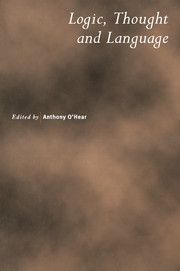Book contents
- Frontmatter
- Contents
- Preface
- Notes on Contributors
- What logic should we think with?
- Mental Representation and Mental Presentation
- Self-knowledge, Normativity, and Construction
- The Normativity of Meaning
- Two Theories of Names
- Relativism and Classical Logic
- Principles for Possibilia
- What are these Familiar Words Doing Here?
- Particular Thoughts & Singular Thought
- Conditional Belief and the Ramsey Test
- Necessary Existents
- Ambiguity and Belief
- Basic Logical Knowledge
- Frege's Target
- Index
Principles for Possibilia
Published online by Cambridge University Press: 05 October 2010
- Frontmatter
- Contents
- Preface
- Notes on Contributors
- What logic should we think with?
- Mental Representation and Mental Presentation
- Self-knowledge, Normativity, and Construction
- The Normativity of Meaning
- Two Theories of Names
- Relativism and Classical Logic
- Principles for Possibilia
- What are these Familiar Words Doing Here?
- Particular Thoughts & Singular Thought
- Conditional Belief and the Ramsey Test
- Necessary Existents
- Ambiguity and Belief
- Basic Logical Knowledge
- Frege's Target
- Index
Summary
The Problem
It seems to be an obvious truth that
(1) There could be something that doesn't actually exist.
That is, it seems to be obviously true that
(1a) ◊∃x(Actually ∼ (x exists)).
It is sufficient for the truth of (1) that there could be more people, or trees, or cars, than there actually are. It is also sufficient for the truth of (1) that there could be some people, or trees, or cars that are distinct from all those that actually exist. Do (1) and suchlike statements involve a commitment to possibilia, to things that possibly exist, but do not actually exist? If not, why not? And if so, what is the nature of the possibilia to which (1) and its ilk commit us? These simple little questions are at the tip of an iceberg.
We have to appreciate the size of the iceberg. Some years ago—more than a quarter of a century ago—I thought that there is no commitment to possibilia in this and suchlike statements. We can call this ‘the no-commitment view’. My reason for accepting the nocommitment view was that if one starts with an object language containing modal operators and an ‘Actually’ operator, one can give a truth-theory for this object language in a metalanguage that takes the modal operators as primitive.
- Type
- Chapter
- Information
- Logic, Thought and Language , pp. 119 - 146Publisher: Cambridge University PressPrint publication year: 2002



